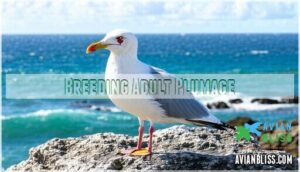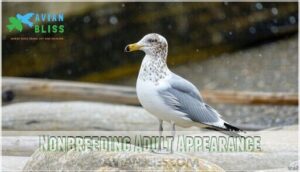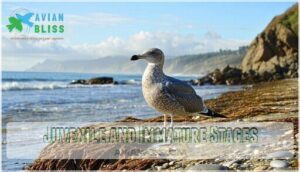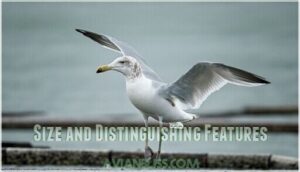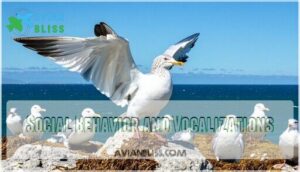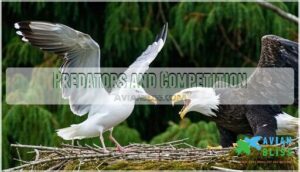This site is supported by our readers. We may earn a commission, at no cost to you, if you purchase through links.
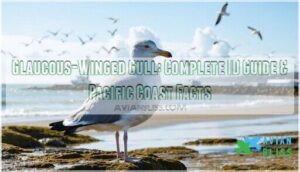 The glaucous winged gull is a large, stocky seabird you’ll spot along the Pacific Coast from Alaska to California. These adaptable gulls measure 20-23 inches long with distinctive pale gray wings and darker wingtips.
The glaucous winged gull is a large, stocky seabird you’ll spot along the Pacific Coast from Alaska to California. These adaptable gulls measure 20-23 inches long with distinctive pale gray wings and darker wingtips.
They’re opportunistic feeders, meaning they’ll eat almost anything—from marine invertebrates and small fish to your leftover beach snacks.
You’ll find them thriving in coastal environments like beaches, harbors, and mudflats, but they’ve also mastered urban living near landfills and fishing docks. Their sturdy build and heavy beak make them excellent scavengers, often working in noisy flocks along shorelines and rocky coasts year-round.
Table Of Contents
- Key Takeaways
- Glaucous-Winged Gull: Species Overview
- Identification Through The Seasons
- Habitat, Range, and Distribution
- Behavior, Diet, and Feeding Habits
- Breeding, Longevity, and Conservation
- Frequently Asked Questions (FAQs)
- Where do Glaucous-winged Gulls live?
- What is the difference between glaucous and Glaucous-winged Gulls?
- Are Glaucous-winged Gulls endangered?
- What are the Glaucous-winged Gulls predators?
- What is the best way to spot Glaucous-winged Gulls?
- Can Glaucous-winged Gulls be kept as pets?
- How do Glaucous-winged Gulls affect human livelihoods?
- Can Glaucous-winged Gulls transmit diseases to humans?
- What is the significance of Glaucous-winged Gulls in coastal ecosystems?
- How do glaucous-winged gulls communicate with each other?
- Conclusion
Key Takeaways
- You’ll easily identify glaucous-winged gulls by their distinctive pale gray wings, stocky 20-23 inch build, and heavy beaks – they’re noticeably larger than most coastal gulls you’ll encounter.
- These opportunistic feeders aren’t picky eaters – they’ll scavenge everything from marine invertebrates and fish to your beach snacks, making them highly adaptable survivors in both natural and urban coastal environments.
- You can spot them year-round along the Pacific Coast, from Alaska to California, where they thrive in beaches, harbors, mudflats, and even landfills, often gathering in large, noisy flocks.
- They’re breeding powerhouses with impressive longevity – these gulls can live over 20 years and establish massive colonies of up to 10,000+ pairs on rocky islands and cliffs during their April-August breeding season.
Glaucous-Winged Gull: Species Overview
You’ll find the Glaucous-winged Gull standing out as one of the Pacific Coast’s most recognizable large gulls, with its distinctive pale gray wings and sturdy build making identification straightforward once you know what to look for.
This hefty seabird combines the typical gull opportunism with specific adaptations that help it thrive in the challenging marine environments from Alaska to California.
Scientific Classification
Within the taxonomic hierarchy, you’ll find the Glaucous-winged Gull positioned as Larus glaucescens in the family Laridae. This classification systems approach places it among over twenty recognized gull species worldwide through phylogenetic analysis.
- Order: Charadriiformes (shorebirds and gulls)
- Family: Laridae (gulls, terns, and skimmers)
- Genus: Larus (true gulls)
- Species: L. glaucescens (Naumann, 1840)
Modern ornithology guide standards confirm its species nomenclature through genetic variation studies, establishing taxonomic rank despite hybridization zones.
Physical Description
You’ll recognize this hefty gull by its impressive size and distinctive features. The Glaucouswinged Gull sports a sturdy body with broad wing span and sturdy build. Its head structure appears large and somewhat flattened, topped with heavy beak shape featuring a thick tip.
Color patterns show pale gray wings with darker wingtips, while body proportions reveal stocky dimensions. Bird size measurement ranges 20-23 inches long, making identification easier when comparing to smaller gulls.
Etymology and Color Significance
The name "glaucous-winged" comes from Latin "glaucus" and Greek "glaukos," meaning gleaming gray or bluish-green. This Color Definition perfectly describes the bird’s distinctive wing coloration. The Greek Influence on Word History shows how ancient observers recognized these Bluish Hues.
Like a Powder Coating on leaves, the glaucous term originally described waxy plant surfaces. This Etymology Explanation reveals why scientists chose this name—the gull’s wings display that same pale, frosted appearance that makes identification easier for birders.
Comparison With Similar Gulls
Distinguishing glaucous-winged gulls from their coastal cousins requires sharp eyes and patience. These birds share similar habitats with several species, making gull identification challenging for beginners.
- Western Gull comparison: Notice the darker gray wings and mantle versus glaucous-winged’s lighter plumage comparison
- Herring Gull differences: Check beak shape – herring gulls show brighter yellow bills with distinct red spots
- Glaucous Gull variations: Size variation helps here, as true glaucous gulls appear bulkier with pure white wingtips rather than gray feather patterns
Understanding the birds’ Arctic habitat adaptations is essential for effective identification and observation in their natural environments.
Identification Through The Seasons
You’ll notice significant changes in the Glaucous-winged Gull’s appearance throughout the year that can help confirm your identification. These seasonal variations affect everything from bill color to wing patterns, making timing essential for accurate field identification.
Breeding Adult Plumage
During breeding season, glaucous-winged gulls showcase flawless white heads and bodies contrasting sharply with pearl-gray wings. Their bright yellow bills develop a vivid red spot that screams "look at me" to potential mates.
Adult molting occurs post-breeding, rejuvenating their plumage coloration for next year’s mating displays. This glaucous bird species maintains feather maintenance through preening, ensuring ideal gull identification features throughout breeding cycles.
Nonbreeding Adult Appearance
When breeding season ends, your glaucous-winged gull sheds its crisp appearance for winter wear. The head pattern shifts dramatically as brownish streaking replaces the clean white. This size and shape change makes field identification trickier during colder months.
Key nonbreeding adult features:
- Feather Coloration becomes duller with extensive brown streaking on head and neck
- Beak Shape remains thick but bill color shifts to yellowish with dark markings
- Head Pattern shows heavy brown mottling instead of flawless white
- Wing Tips maintain pale gray coloring without dark markings
- Plumage Texture appears slightly more disheveled than breeding birds
The glaucous coloring persists on wings and back, helping distinguish this bird species from similar gulls year-round. Understanding bird identification techniques is vital for accurately identifying the glaucous-winged gull during different seasons.
Juvenile and Immature Stages
Young glaucous-winged gulls undergo dramatic transformations during their four-year journey to adulthood. Juvenile migration begins shortly after fledging, with birds showing mottled brown plumage and dark bills. Molting patterns reveal lighter feathers gradually replacing darker ones. Growth rates vary, but feather development follows predictable stages.
Plumage variation among juveniles can confuse birders comparing glaucous gull species. Cornell Lab of Ornithology’s All About Birds provides excellent bird species comparison photos.
Size and Distinguishing Features
You’ll notice this glaucouswinged gull’s impressive size immediately – they’re hefty birds measuring 20-23 inches with substantial wing span. Their bill shape features a thick, angled lower edge that’s longer than smaller gull species. The head size appears flat and broad, giving them a distinctive profile.
Relative size comparisons help with bird species identification – they’re remarkably larger than Iceland gulls but smaller than Great Black-backed gulls, making size shape essential for distinguishing this glaucous gull from similar coastal species.
Habitat, Range, and Distribution
You’ll find Glaucous-winged Gulls year-round along the Pacific Coast from southern Alaska to Oregon, with some birds moving south to California in winter.
These adaptable gulls thrive in coastal environments including beaches, harbors, mudflats, and estuaries where they often mix with other gull species in large feeding flocks.
Pacific Coastline and Shorelines
Along Pacific shorelines, you’ll spot Glaucous-winged Gulls thriving where ocean meets land. These adaptable birds navigate coastal erosion zones and shifting tidal patterns with ease. They frequent beaches, rocky shores, and harbors where marine debris provides feeding opportunities.
Understanding shoreline ecology helps with gull habitat identification during your shoreline birdwatching adventures.
Seasonal Movements and Migration
While coastal populations display distinct migration patterns during fall and spring, many Glaucous-winged Gulls remain year-round residents along Pacific shorelines. Bird tracking reveals these gulls follow established flyway ecology routes from Alaska to Mexico, with wintering grounds concentrated in sheltered bays.
Their seasonal habitat preferences drive predictable movements, making them reliable subjects for studying Pacific coastline birds and gull habitat dynamics. The study of migration patterns is essential for understanding the behavior and population dynamics of Glaucous-winged Gulls.
Preferred Environments
You’ll find these adaptable gulls thriving across diverse Coastal Ecosystems and Marine Habitats along the Pacific Coastline Birds. They’re equally at home in Freshwater Sources like lakes and rivers, Terrestrial Environments including fields and dumps, and Urban Landscapes where food’s abundant.
Their adaptable nature makes Wildlife Habitat Exploration rewarding, as their Bird Foraging Behavior spans multiple environments flawlessly.
Mixed Flocks and Hybrid Zones
You’ll spot glaucous-winged gulls mixing freely with other species in coastal flocks. These mixed species gatherings create fascinating zone interactions where genetic exchange occurs through hybridization patterns.
Watch for varying degrees of glaucousness among individuals – some show pure traits while others display blended characteristics from cross-breeding. **These flock interactions reveal ongoing evolutionary processes in real-time.
Behavior, Diet, and Feeding Habits
You’ll find these adaptable gulls feeding on almost anything they can find, from fish and shellfish to garbage and bird eggs.
They’re skilled at both diving for prey and scavenging along beaches, often working in noisy flocks that communicate through a variety of calls and aggressive displays.
Omnivorous and Opportunistic Feeding
What drives this glaucous-winged giant’s exceptional adaptability? This Bird Species Overview reveals impressive Feeding Strategies spanning over twenty food categories. Their Foraging Tactics shift seasonally, matching availability from salmon spawning runs to urban waste sites. Prey Capture includes marine invertebrates, small mammals, eggs, and plant material.
Urban populations dedicate sixty percent of feeding time to landfills, demonstrating flexible Nutrient Acquisition that enhances their Size Shape advantage across diverse Pacific environments. The gull’s feeding behavior is also influenced by effective gull feeding products.
Scavenging and Foraging Strategies
Through relentless pursuit, these gulls master diverse Foraging Techniques that showcase notable Feeding Strategy Adaptation. Their Scavenging Behavior transforms any coastline into a buffet opportunity.
Food Source Diversity includes:
- Fish stolen from smaller seabirds through aggressive kleptoparasitism
- Marine invertebrates extracted using specialized Prey Capture Methods
- Human food scraps scavenged from docks and beaches
- Eggs and chicks raided from neighboring colony nests
This Bird Species Overview reveals how their substantial Size Shape and Relative Size advantage facilitates successful competition with smaller gulls for prime feeding territories. The gulls’ ability to thrive in various environments is also influenced by effective gull feeding products.
Social Behavior and Vocalizations
You’ll notice glaucous-winged gulls form complex social hierarchies within their colonies. Flock interactions shift constantly as birds communicate through distinctive calls and aggressive postures. Their vocal learning abilities help them adapt communication styles to different situations.
During breeding season, elaborate mating rituals showcase their glaucous wing patterns. These intelligent birds establish pecking orders through subtle behavioral cues rather than constant fighting.
Predators and Competition
During breeding season, these resilient gulls face constant pressure from bald eagles and neighboring species. You’ll witness their outstanding territorial defense strategies as they navigate fierce competition for prime nesting spots and food sources.
- Nesting Predators: Bald eagles target up to 75% of exposed colonies, forcing gulls into defensive formations
- Food Competitors: Western Gulls create hybrid zones where resources become scarce and competition intensifies
- Territorial Defense: Dense vegetation provides essential predator avoidance, improving chick survival rates dramatically
The gulls’ breeding success is influenced by factors such as habitat characteristics.
Breeding, Longevity, and Conservation
You’ll find these gulls establish breeding colonies on rocky cliffs and islands along the Pacific coast from April through August.
These hardy seabirds can live over 20 years in the wild, though they face growing challenges from plastic pollution and habitat disruption despite their current stable population status.
Nesting Colonies and Reproduction
During peak season, you’ll find these glaucous-winged gulls gathering in massive colonies on rocky islands and coastal cliffs. Their reproductive strategies center around synchronized timing, with pairs establishing territories through elaborate courtship displays. Chick development follows predictable patterns, though breeding success varies considerably based on food availability and weather conditions.
| Colony Dynamics | Nesting Habits | Reproductive Strategies |
|---|---|---|
| 500-10,000+ pairs | Ground scrapes lined with vegetation | Monogamous seasonal pairs |
| Territorial displays defend 2-3m radius | Prefer elevated rocky ledges | Synchronized egg laying |
| Mixed-age social hierarchies | 2-3 eggs per clutch typical | Biparental care system |
| Aggressive toward intruders | 28-day incubation period | Cooperative territory defense |
| Peak activity May-July | Chicks fledge at 45-50 days | High site fidelity rates |
Lifespan and Survival Rates
You’ll find these glaucous-winged beauties usually survive around 15 years in the wild. However, longevity studies reveal exceptional survival strategies—some individuals break free from average mortality factors, reaching over 21 years.
Age distribution shows their glaucousness develops through four distinct stages before adulthood.
Population trends indicate stable survival rates despite various environmental challenges affecting coastal bird communities. Understanding bird lifespan factors is essential for conservation efforts and protecting these species.
Conservation Status and Threats
You’ll find Glaucous-winged Gulls classified as "Least Concern" globally, yet they face mounting challenges. Pollution effects from urban environments double contaminant levels in eggs compared to offshore colonies. Climate change disrupts prey abundance and nesting habitat. Human impact through fishing debris causes frequent entanglement injuries.
- Habitat Loss: Coastal development eliminates vital nesting sites along urbanized shorelines
- Marine contamination: PFAS and heavy metals accumulate in tissues, affecting reproduction success
- Fishing hazards: Discarded hooks and lines create deadly traps for scavenging birds
Human Impacts and Adaptability
Despite urban pollution effects, glaucous-winged gulls show outstanding ecological resilience through climate adaptation. Their glaucousness helps with water repellence, while coastal development forces behavioral shifts.
These adaptable birds thrive on human interaction, scavenging city refuse like nature’s cleanup crew. Their flexibility mirrors plant protection strategies, demonstrating how wildlife navigates our changing world.
Frequently Asked Questions (FAQs)
Where do Glaucous-winged Gulls live?
You’ll spot these coastal wanderers roaming Pacific shores from Alaska to California. They’re comfortable calling beaches, bays, estuaries, and nearby inland waters home, following fish and marine life seasonally.
What is the difference between glaucous and Glaucous-winged Gulls?
Glaucous" describes a bluish-gray color or waxy coating on surfaces, while "Glaucous-winged Gulls" are specific large seabirds with grayish-blue wing feathers found in coastal North American areas.
Are Glaucous-winged Gulls endangered?
While their future hangs in the balance, you’ll find relief knowing Glaucous-winged Gulls aren’t endangered. They’re currently listed as "Least Concern" with stable populations, though they face threats from pollution and plastic ingestion.
What are the Glaucous-winged Gulls predators?
Major aerial predators hunt you – falcons, hawks, eagles target adults, while weasels, foxes raid your nests for eggs and chicks. Ground-level threats keep you alert constantly.
What is the best way to spot Glaucous-winged Gulls?
Carefully cruise coastal areas during low tide when these hefty gulls congregate near shorelines. You’ll recognize their distinctive gray-blue wingtips, large size, and heavy bills while they’re scavenging for food.
Can Glaucous-winged Gulls be kept as pets?
No, you can’t keep Glaucous-winged Gulls as pets. They’re protected wild birds under federal law, requiring special permits that aren’t available for pet ownership.
They need specialized care and natural habitats to thrive.
How do Glaucous-winged Gulls affect human livelihoods?
These large seabirds can wreak havoc on your coastal business operations. They’ll raid garbage bins, damage property with their droppings, and aggressively compete for fish, reducing your catch yields substantially.
Can Glaucous-winged Gulls transmit diseases to humans?
Yes, these birds can carry diseases that affect humans. Research shows they harbor zoonotic pathogens like Salmonella, Campylobacter, and Chlamydia. You’ll face infection risks through contact with their droppings or contaminated surfaces.
What is the significance of Glaucous-winged Gulls in coastal ecosystems?
Like ocean janitors working tirelessly along the shore, you’ll find Glaucous-winged Gulls serving as vital scavengers that clean beaches and control marine populations, maintaining ecosystem balance through their diverse feeding habits.
How do glaucous-winged gulls communicate with each other?
You’ll observe glaucous-winged gulls using vocalizations, body language, and visual displays to communicate. They employ harsh calls, head bobbing, aggressive posturing, and synchronized movements to convey territorial claims, mating intentions, and social hierarchies.
Conclusion
Amazingly, the glaucous winged gull can live over 25 years in the wild, making it one of the longest-lived seabirds on the Pacific Coast. Now you’ve got the complete toolkit to identify these outstanding birds wherever you encounter them.
Whether you’re watching them patrol busy harbors or nest on remote cliffs, you’ll recognize their pale gray wings and sturdy build instantly.
These adaptable survivors continue thriving despite urban pressures, proving that some wildlife species can successfully coexist with human development along our coastlines.
- https://docs.google.com/forms/d/1GAQr3Kn1cURCVHUA82hAga1Wv8DCH0IuqDLRUrOpN7M/viewform?ts=63f4f653&entry.1515682415=https://www.merriam-webster.com/dictionary%2Fglaucous
- https://premium.britannica.com/mw-unabridged/?utm_source=mw&utm_medium=inline-def&utm_campaign=evergreen
- https://darwin-online.org.uk/EditorialIntroductions/vanWyhe_Chua_Darwins_last_book_Bloom.html
- https://www.illinoiswildflowers.info/index.htm
- https://www.researchgate.net/publication/362808786_Assessing_the_role_of_glaucousness_in_imparting_tolerance_to_moisture_and_heat_stress_in_wheat

